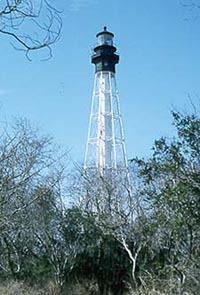Year first constructed 1828 Automated 1963 Opened 1828 Range 33,336 m Added to NRHP 23 June 2003 | Year first lit 1895 Height 58 m Area 4 ha Material Cast iron | |
 | ||
Location Smith Island off Cape Charles at the mouth of the Chesapeake Bay Construction cast iron skeleton tower Tower shape Octagonal pyramidal skeleton Similar Smith Point Light, Old Plantation Flats Light, New Point Comfort Light, Thimble Shoal Light, Newport News Middle Gr | ||
Cape charles light house
The current Cape Charles Light is an octagonal steel skeleton tower lighthouse at the mouth of the Chesapeake Bay on Smith Island. It is the tallest lighthouse in Virginia and the second tallest in the United States. This particular tower is the third lighthouse at this location. The first lighthouse at Cape Charles was a 55-foot (17 m) masonry tower completed in 1828. It was quickly deemed inadequate for its important seacoast location due to its low height and poor visibility at sea. It was soon threatened by erosion so in 1864 it was replaced by a 150-foot (46 m) masonry tower built further inland. Located a little more than a mile southwest of the old tower and 600 feet from the shoreline, the impressive 150-foot-tall conical brick tower was similar in appearance to the 1857 Cape May Lighthouse, painted white and topped with a dark brown lantern room. In 1892, a twenty-five-foot red band was painted around the white tower’s midsection, about sixty feet up from the base, to make it more visible during the day. By the 1890s, it too was threatened by beach erosion which jetties built to protect it failed to halt, and with the lighthouse now only 300 feet from the ocean and the shoreline eroding at a rate of 37 feet per year it was decided that a third lighthouse needed to be built three quarters of a mile inland.
Contents
Map of Cape Charles Lighthouse, Cape Charles, VA 23310, USA
The first proposal for Cape Charles’ third lighthouse called for a conical structure of iron plates, similar in design to the new Cape Henry Lighthouse, but in the end, a bid of $78,200 was accepted to construct 191-foot (58 m) octagonal steel skeletal towers at both Cape Charles and Hog Island, a barrier island twenty miles to the north where another lighthouse was being threatened by shoreline erosion. This design had several advantages: it was much cheaper than the Cape Henry model, less susceptible to punishing winds, and distinct enough from the Cape Henry tower that the two would not be mistaken for each other.
The new station’s lens was installed and tested in June 1895, however, its full-time service was delayed until mid-August so mariners could be properly informed of the station’s new light characteristic. Lt. Frederick Mahan of the Lighthouse Board proposed that all U.S. lighthouses be given a “numerical flash” pattern. The first-order lens at Cape Charles made a complete revolution every thirty seconds, producing nine flashes: four quick flashes followed by a dark interval of three seconds, then five more flashes followed by sixteen seconds of darkness. Cape Charles would thus have a 4-5 pattern, and mariners could easily associate these numbers with Cape Charles. This numbering system was likened to a fire alarm bell stroking out the exact numerical identity of a beleaguered building. “By this method,” Mahan maintained, “the light is identified absolutely…” Due to the high cost of these special lenses, only the “4-5” light at Cape Charles, and the “1-4-3” light at Minots Ledge were ever deployed.
With a height of 191 feet, the third and final Cape Charles tower is the second tallest lighthouse in the United States. The tower consists of a central iron tube surrounded by eight massive legs. A spiral staircase with 216 treads, enclosed in the tube, leads upwards to the generator room. Ascending seventeen more steps from there, one arrives at the watch room, where the lower gallery may be accessed. The tower is painted white, while the upper rooms are a contrasting black.
The lens was removed from the second Cape Charles Lighthouse in October 1895, and on June 1, 1896, the speed of rotation of the lens in the new tower was cut in half as the flashes were being produced in such quick succession that they were indistinct when viewed from a distance. After having served as an observation tower during World War I the second Cape Charles Lighthouse finally toppled into the ocean on July 2, 1927. Both the Cape Charles light and the Hog Island Light were electrified in 1933, completing the electrification of all coastal beacons in the fifth lighthouse district.
In 1963 the lighthouse was fully automated and the first order Fresnel Lens was replaced by a more powerful DCB-224 aerobeacon. The original lens from the Cape Charles lighthouse is on display at the Mariners' Museum in Newport News, Virginia. The Cape Charles Lighthouse now houses a modern Vega VRB-25 solar powered beacon.
A brush fire on July 13, 2000, burned down the 1895 head keeper’s dwelling, a wood privy, and a storage shed. The two assistant keeper’s dwellings were torn down around 1960, prior to automation of the lighthouse, but the head keeper's house, along with an oil house and generator building, had been sold to a hunting club before being taken over by The Nature Conservancy in 1995.
